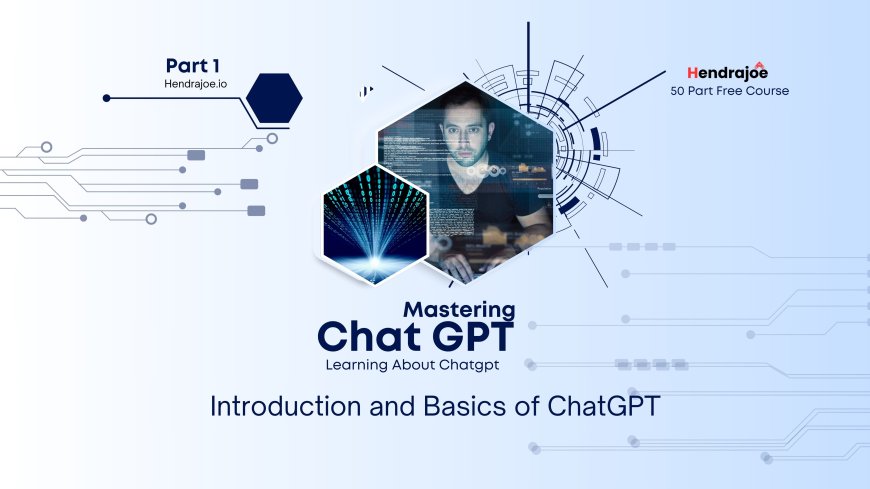Introduction and Basics of ChatGPT
Learn the basics of ChatGPT, an AI language model by OpenAI. Discover how ChatGPT works, its key features, applications, and how to use it for various tasks like content generation, customer support, and more

In the past few years, Artificial Intelligence (AI) has made significant strides in revolutionizing the way we interact with technology. One of the most prominent advancements in this field is ChatGPT—an AI model developed by OpenAI. ChatGPT has gained widespread attention for its ability to engage in human-like conversations, generate content, and assist in various tasks such as writing, problem-solving, and even coding. This article will provide a comprehensive introduction to ChatGPT, explain its basic features, and explore its applications and potential use cases.
What is ChatGPT?
ChatGPT is an advanced language model powered by AI, developed by OpenAI. It stands for Chat Generative Pretrained Transformer. The model is built using a deep learning architecture known as the Transformer, which enables it to process and generate natural language text in a way that mimics human conversation. ChatGPT has been trained on vast amounts of text data from books, websites, and other sources, which allows it to understand and respond to a wide range of queries across various topics.
The development of ChatGPT has been part of OpenAI’s mission to create safe and useful AI models that can assist humans in a variety of ways. Unlike traditional chatbots, which rely on pre-programmed responses, ChatGPT can generate contextually relevant responses to dynamic input, making it highly adaptable and capable of having more meaningful conversations.
How Does ChatGPT Work?
At its core, ChatGPT relies on a machine learning technique called transformer-based neural networks. The model was trained using a vast dataset that includes text from books, articles, and websites. This training allows ChatGPT to understand the nuances of language, including grammar, syntax, context, and even subtle aspects like humor and tone.
The key component of ChatGPT is its pretrained nature. This means that before being fine-tuned for specific tasks, the model is trained on a general dataset, which helps it develop a broad understanding of language. Afterward, fine-tuning allows the model to improve its performance in specific applications, such as customer service or content generation.
Tokenization
One of the main aspects of how ChatGPT processes language is tokenization. Tokenization refers to breaking down text into smaller chunks, known as tokens. These tokens could be words, parts of words, or even punctuation marks. By processing these tokens, ChatGPT can understand the structure and meaning of the input text and generate coherent, relevant responses.
Attention Mechanism
The attention mechanism is another vital feature of the Transformer architecture. This mechanism allows ChatGPT to focus on different parts of the input text at different times, depending on their relevance. By using attention, ChatGPT can understand which words or phrases are crucial in generating an appropriate response, even if they are not located close to each other in the text.
Key Features of ChatGPT
ChatGPT has a wide range of features that make it an incredibly versatile tool for both personal and professional use. Some of the most notable features include:
1. Human-like Conversations
One of the defining characteristics of ChatGPT is its ability to engage in human-like conversations. Unlike traditional chatbots, which often sound robotic and fail to understand the context of a conversation, ChatGPT can carry on conversations with a natural flow. It can answer questions, provide explanations, and even engage in casual banter, all while maintaining a conversational tone.
2. Contextual Understanding
ChatGPT is capable of understanding the context of a conversation, which allows it to generate more relevant and coherent responses. This contextual awareness enables the model to hold longer conversations without losing track of the topic or repeating itself unnecessarily.
3. Content Generation
ChatGPT excels in content generation. It can be used to write articles, blog posts, product descriptions, and much more. By providing the model with a prompt or topic, you can quickly generate high-quality written content that is both informative and engaging.
4. Multilingual Capabilities
ChatGPT is not limited to just English. It has been trained on text data in multiple languages, allowing it to respond to queries in several different languages, including Spanish, French, German, Chinese, and many more. This makes it a useful tool for global communication and content generation.
5. Problem Solving and Assistance
Beyond conversational tasks, ChatGPT is also capable of solving problems, providing recommendations, and offering assistance in a wide range of fields. Whether you're looking for advice on a technical issue, assistance with writing code, or recommendations for a book, ChatGPT can help.
Applications of ChatGPT
ChatGPT has found applications in a variety of industries and sectors, ranging from customer service to education, entertainment, and healthcare. Below are some of the most notable use cases:
1. Customer Support
ChatGPT can be integrated into customer service platforms to provide instant responses to customer queries. It can assist with troubleshooting, answering frequently asked questions, and providing product recommendations, thereby improving customer satisfaction and reducing the workload on human agents.
2. Content Creation
Content creators can use ChatGPT to generate blog posts, social media updates, and even creative writing. With its ability to generate coherent and contextually relevant text, ChatGPT helps save time and effort while maintaining high-quality content.
3. Education and Tutoring
ChatGPT can act as a personal tutor, helping students learn new topics and improve their knowledge in various subjects. Whether it's explaining complex scientific concepts or providing practice exercises, ChatGPT can be an invaluable educational tool.
4. Translation and Language Learning
Due to its multilingual capabilities, ChatGPT can assist with translation and language learning. It can translate text between languages and help users improve their language skills by providing explanations, examples, and practice exercises.
5. Healthcare
In the healthcare industry, ChatGPT can assist doctors and healthcare professionals by providing information on medical conditions, treatments, and procedures. While it is not a replacement for a licensed medical professional, it can serve as an initial point of contact or an educational tool for patients.
6. Entertainment and Creative Writing
ChatGPT has also gained popularity in the entertainment and creative writing fields. Writers, game developers, and content creators use ChatGPT to generate plot ideas, write dialogue, and brainstorm creative concepts. The AI's ability to understand narrative structure and generate engaging content makes it a valuable tool for creative professionals.
How to Use ChatGPT
Using ChatGPT is straightforward, especially if you have access to platforms like OpenAI’s API or third-party applications that integrate the model. Here’s how you can start using ChatGPT for various tasks:
1. Sign Up for Access
To use ChatGPT, you first need to sign up for access to OpenAI's platform. Once you have access, you can interact with the model via API, which allows you to integrate it into your own applications, or through platforms that offer ChatGPT as a service.
2. Provide Prompts
When interacting with ChatGPT, you can start by providing a prompt—a brief sentence or question that tells the model what you're looking for. For example, you might type, “Can you explain quantum mechanics?” or “Write a blog post about the benefits of remote work.”
3. Refining Responses
After receiving a response from ChatGPT, you can refine it by providing additional context or clarifying your request. This iterative process allows you to generate more accurate and tailored content.
4. Customization
ChatGPT can be fine-tuned to meet specific needs. For instance, businesses can train the model to respond in a particular tone, while educators can adjust it to provide more concise explanations for students. Fine-tuning enhances the model’s relevance to the task at hand.
Limitations of ChatGPT
Despite its impressive capabilities, ChatGPT is not without limitations. It’s important to understand these limitations to use the model effectively:
1. Lack of Real-World Understanding
While ChatGPT is skilled at processing and generating text, it lacks true comprehension of the world. It can provide factual information, but it may also generate inaccurate or outdated answers. It’s essential to verify the information provided by ChatGPT, especially for critical or technical subjects.
2. Bias in Responses
Like any AI trained on large datasets, ChatGPT may exhibit biases present in the data. It’s important to be mindful of this when using the model for sensitive topics, as it could unintentionally reinforce stereotypes or generate biased content.
3. Contextual Limitations
While ChatGPT can handle context well, there are still limits to how much information it can remember during a conversation. For instance, long conversations or complex queries may result in the model losing track of the conversation or generating responses that don't align with previous inputs.
Conclusion
ChatGPT represents a groundbreaking advancement in AI technology, offering versatile applications in a wide range of fields. From enhancing customer service to assisting with content creation and education, the potential uses for ChatGPT are virtually limitless. While there are still some limitations to the model, its ability to generate human-like responses and understand context makes it a valuable tool for both personal and professional tasks.
As AI continues to evolve, it is likely that ChatGPT and similar models will become an even more integral part of our daily lives, transforming the way we interact with technology and paving the way for new innovations in artificial intelligence.
What's Your Reaction?





































